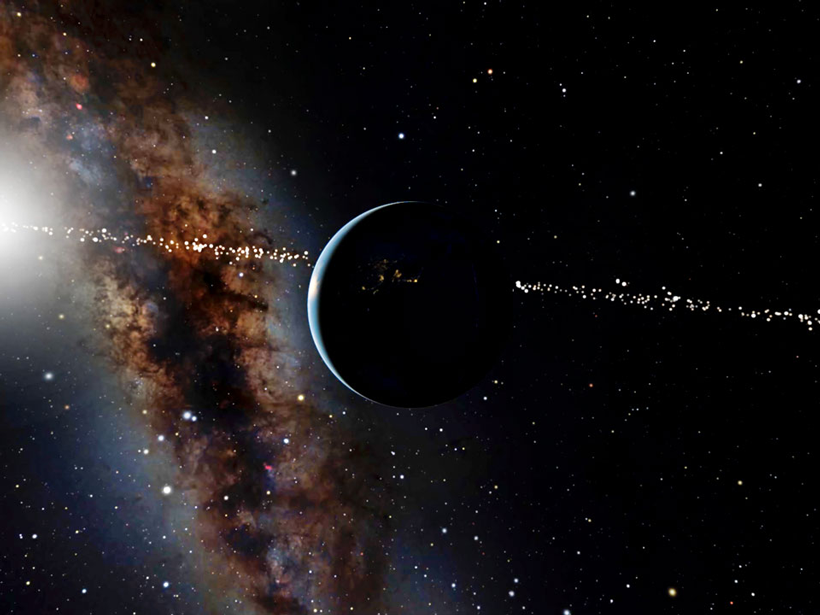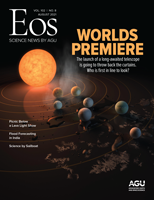The Milky Way is home to billions of stars and probably an even larger number of planets. To search for these planets, scientists watch for minute, but periodic, dips in a star’s light, the telltale signature of a planet passing in front of its host star. And now a team of astronomers has turned that search homeward.
Lisa Kaltenegger and Jackie Faherty calculated the number of stars whose past, present, or future vantage points in space afford a look at Earth passing in front of the Sun. The planets that orbit these roughly 2,000 stars, some of which have additionally been bathed in human-made radio waves, are poised to spot Earth, the researchers suggest.
Turning the Tables
Astronomers have confirmed the existence of more than 4,000 extrasolar planets, and we’re now turning the tables, said Kaltenegger, an astronomer at Cornell University in Ithaca, N.Y. “It’d be interesting to know if someone could have seen us.”
Kaltenegger and Faherty, an astrophysicist at the American Museum of Natural History in New York City, mined data collected by the European Space Agency’s Gaia mission. The Gaia spacecraft, launched in 2013, is conducting the most precise survey to date of the motions and positions of more than a billion stars in the Milky Way. “It’s the greatest kinematic and astrometric catalog of our time,” said Faherty.
A Thin Ring in Space
The researchers honed in on stars within the so-called Earth transit zone, a ring-shaped region of space created by projecting Earth’s orbit around the Sun outward into the cosmos. Any stars—and, by extension, the planets orbiting them—located within this zone see Earth passing in front of the Sun. Astronomers on Earth have exploited this geometry, known as a transit, to detect thousands of far-away planets.
Recent studies of Earth’s transit zone have typically focused on the stars within it right now, said René Heller, an astrophysicist at the Max Planck Institute for Solar System Research in Germany not involved in the research. In 2016, Heller and a colleague published a study defining Earth’s transit zone and showing that roughly 80 stars could currently see Earth transiting the Sun. “We didn’t care too much about the temporal aspect,” he said.
But Kaltenegger and Faherty have now considered the changing vantage points of stars over time, into and out of Earth’s transit zone. That’s an important distinction, said Heller, because stars are in constant motion around the center of the galaxy. A solar system that observes Earth as transiting now might not have the same view in the future, he said.
Kaltenegger and Faherty restricted their analysis to the roughly 331,000 stars in the Gaia Catalog of Nearby Stars. These stars, all within roughly 300 light-years of Earth, are the best candidates for follow-up study given their relative proximity, said Faherty.
Past, Present, and Future Viewpoints
The researchers then propagated the motions of these stars backward and forward in time. At each annual time step over a 10,000-year window, they determined whether a star fell within Earth’s transit zone. The researchers found that 313 stars were in this zone in the past, 1,402 are in it currently, and 319 will enter it in the future. (Seventy-five of the closest stars in the sample receive yet another tip-off to Earth’s presence: These worlds are close enough to us to have already been bathed in human-produced radio waves.)
Astronomers already know that 7 of these 2,034 stars host planets—17 are known thus far, including 7 in the TRAPPIST-1 system. Many more, if not most, of the remaining stars likely also have their own planets, all of which could see Earth passing in front of the Sun. To get a handle on the total number of rocky, habitable planets potentially orbiting these stars, Kaltenegger and Faherty conservatively estimated that 25% of stars host such a planet. That means that more than 500 planets could witness Earth transiting the Sun, the team concluded.
These results were published in Nature in June.
Future observations in the search for extraterrestrial life ought to target these worlds, said Faherty. They’re the ones closest to us and most likely to have spotted Earth, she said. “These are our best shots.”
—Katherine Kornei (@KatherineKornei), Science Writer
Citation:
Kornei, K. (2021), Thousands of stars view Earth as a transiting exoplanet, Eos, 102, https://doi.org/10.1029/2021EO160970. Published on 22 July 2021.
Text © 2021. The authors. CC BY-NC-ND 3.0
Except where otherwise noted, images are subject to copyright. Any reuse without express permission from the copyright owner is prohibited.


